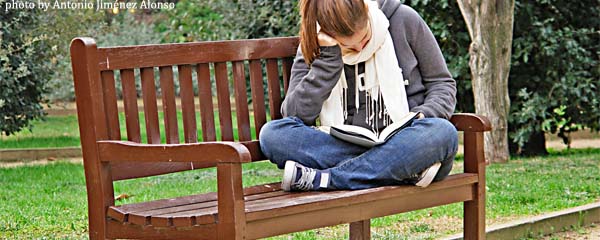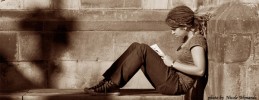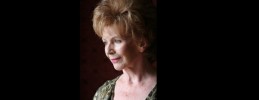
photo by Antonio Jiménez Alonso
by Felicity Skelton
In 2010 I attended the huge international short story conference in Toronto. Many of my favourite writers were there – Margaret Atwood, Bharati Mukherjee, Jane Rogers, Olive Senior – and I discovered some I hadn’t known – Robert Olen Butler, Clark Blaise, Mark Antony Jarman, and the glorious Alistair MacLeod. (The father of Alexander, whose collection Light Lifting has been recommended by Mary Jo Anderson in these pages.)
Then in a bookshop, I found a collection, Forms of Devotion: Stories and Pictures, by another writer I had never heard of, Diane Schoemperlen. I took it to read on the plane home because it was attractive to look at and not too heavy to carry in my handbag, and by the time we landed in England I had read it all, and sometimes cried and sometimes laughed loudly and suddenly, which must have been annoying for neighbouring passengers.
Diane Schoemperlen is a Canadian writer who lives in Ontario. She has published seven short story collections and four novels, and was granted the Governor-General’s award for literature for this book.
In an interview, Schoemperlen admits to ‘a penchant for making lists and for writing in short sections’, and most of the stories in Forms of Devotion have some formal quirk or experiment with structure. When asked why she included the pictures, Schoemperlen said ‘To make a beautiful book’ but they are also an integral part of the stories. Sometimes collages, which Schoemperlen makes herself, and at other times straight reproductions, they are taken from non-copyright, Victorian-period etchings and illustrations. Some, such as those in ‘On Looking Further into the Bodies of Men’, ‘The Spacious Chambers of her Heart’ and ‘Body Language’ are clearly medical illustrations, and others portray nymphs and goddesses in flimsy drapery or domestic scenes, perhaps from melodramas. ‘In some cases, I had the idea for the story first and then found illustrations or made collages to go with the text’ says Schoemperlen. ‘In other stories, it worked the other way around.’
But it is the words which make the stories, and a wicked sense of humour and irony which takes the reader by surprise just when they think they know where a story may be going.
For example, in ‘Count Your Blessings (A Fairy Tale)’, which begins ‘Once upon a time there was a young woman named Grace.’ The story recounts how Grace, who is perfect in almost every respect, marries a tall, dark handsome man and is very happy until the second child comes along and she finds herself at home looking after the (perfect) house and the children, while William, the perfect husband (he is wonderful with the children too) goes out to work. The narrative charts Grace’s decline into depression and frustration with her life, without ever spelling out what is happening to her. She talks to her women friends, and they are vociferous in their insistence that they are far worse off than she can possibly be.
They beat their breasts and pulled out their hair. They banged their pretty heads against the pretty walls. They tore off their clothes till there were heaving bosoms and big brown nipples everywhere.
And yet this story is, as are so many of them, poignant as well as funny, deeply felt even when the narrating voice seems to be most detached. The end of this story gives the reader a jolt which I certainly wasn’t expecting.
‘On Looking Further into the Bodies of Men’ is probably my own favourite in the collection. With accompanying anatomical drawings, the story lists the attractions of the male body to a female eye, as well as some of the less appealing aspects. Nothing is forgotten, and it is very funny as well as being a love song to the male.
Some men’s ears have hair growing out of the holes in unruly black tufts. You might assume that this is why he never seems to hear half of what you’re saying: his ears are plugged with hair. But the truth is that a man’s sense of hearing is not as sharp as a woman’s. This explains why he never hears the phone ringing, the dog barking, or the baby crying in the middle of the night.
This may seem flippant, but consider another passage, concerning the nape of the neck:
It, like the wrist, emits an aura of vulnerability and sensitivity. Herein lies its power. It is best observed by accident when he does not know you’re watching him. The sudden sight of the downy nape of a male neck bent over a book in a yellow circle of lamplight will set off a spasm of love in your sentimental throat, your startled heart.
This is what makes stories of the pieces in this collection, rather than essays or journalism. The detailed, careful narration of observations which reveal a character even while you think you’re reading a list of incidents or objects or commands, so that when you finally come to the end of the story you find yourself smiling, or weeping ruefully as you recognise another sea-change in a woman’s life, or a portrait of a human being in anguish.

